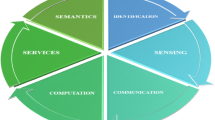Abstract
paper presents a novel approach to model and represent chipless radio-frequency identification (RFID) frequency signatures. The approach involves the geometrical representation of chipless RFID frequency signatures in a signal space. A small set of orthonormal basis functions is derived using singular value decomposition in order to represent the 2b possible tag signatures of a b-bit chipless tag. Each tag signature is represented as a point in an L-dimensional signal space, and minimum distance detection is used to extract the information bit sequence of the tag. Detection error probability is also examined through analytical derivations and Monte Carlo simulation. A set of 3-bit tags were fabricated to validate the approach. Experimental results show that the new approach is capable of accurately detecting information contained in chipless RFID tags. This approach offers a solid mathematical framework for developing novel detection methods for chipless tags.












Similar content being viewed by others
References
Preradovic S, Karmakar NC (2010) Chipless RFID: bar code of the future. IEEE Microw Mag 11(7):87–97
Preradovic S, Balbin I, Karmakar NC, Swiegers G (2008) A novel chipless RFID system based on planar multiresonators for barcode replacement. In: RFID, 2008 IEEE international conference on, Las Vegas, pp 289–296
Kalansuriya P, Karmakar N (2011) Time domain analysis of a backscattering frequency signature based chipless RFID tag. In: Microwave conference proceedings (APMC), Asia-Pacific, pp 183–186
Kalansuriya P, Karmakar N (2012) UWB-IR based detection for frequency-spectra based chipless RFID. In: Microwave symposium digest (MTT), 2012 IEEE MTT-S international, Montreal, pp 1–3
Chamarti A, Varahramyan K (2006) Transmission delay line based ID generation circuit for RFID applications. IEEE Microw Wirel Compon Lett 16(11):588–590
Hu S, Law CL, Dou W (2008) A balloon-shaped monopole antenna for passive UWB-RFID tag applications. IEEE Antennas Wirel Propag Lett 7:366–368
Shao B, Chen Q, Amin Y, David SM, Liu R, Zheng L-R (2010) An ultra-low-cost RFID tag with 1.67 Gbps data rate by ink-jet printing on paper substrate. In: Solid state circuits conference (A-SSCC), IEEE Asian, pp 1–4
Goldsmith A (2005) Wireless communications. Cambridge University Press, New York
Lazaro A, Ramos A, Girbau D, Villarino R (2011) Chipless UWB RFID tag detection using continuous wavelet transform. Antennas Wirel Propag Lett IEEE 10:520–523
Dullaert W, Reichardt L, Rogier H (2011) Improved detection scheme for chipless RFIDs using prolate spheroidal wave function-based noise filtering. Antennas Wirel Propag Lett IEEE 10:472–475
Girbau D, Lorenzo J, Lazaro A, Ferrater C, Villarino R (2012) Frequency-coded chipless RFID tag based on dual-band resonators. Antennas Wirel Propag Lett IEEE 11:126–128
Kalansuriya P, Karmakar N, Viterbo E (2011) Signal space representation of chipless RFID tag frequency signatures. In: Global telecommunications conference (GLOBECOM 2011), 2011 IEEE, Houston, pp 1–5
Haykin S, Moher M (2009) Communication systems, 5th edn. Wiley India Pvt. Limited
Preradovic S, Karmakar NC (2009) Design of fully printable planar chipless RFID transponder with 35-bit data capacity. In: icrowave conference, 2009. EuMC 2009. European, Rome, pp 13–16
Preradovic S, Balbin I, Karmakar NC, Swiegers GF (2009) Multiresonator-based chipless RFID system for low-cost item tracking. IEEE Trans Microw Theory Tech 57(5):1411–1419
Strang G (2009) Linear algebra and its applications, 4th edn. Wellesley-Cambridge, Cambridge
Boyd S Lecture 16. SVD applications. Stanford University, (2007–2008). http://see.stanford.edu/materials/lsoeldsee263/16-svd.pdf. Accessed 12 Jan 2010
Balanis CA (2005) Antenna theory analysis and design, 3rd edn. Wiley, Hoboken
Preradovic S, Karmakar NC (2009) Design of short range chipless RFID reader prototype. In: Intelligent sensors, sensor networks and information processing (ISSNIP), 2009 5th international conference on, Melbourne, VIC, pp 307–312
Koswatta R, Karmakar N (2010) Moving average filtering technique for signal processing in digital section of UWB chipless RFID reader. In: Microwave conference proceedings (APMC), 2010 Asia-Pacific, Japan, pp 1304–1307
Simon MK, Alouini M-S (2005) Digital communication over fading channels, 2nd edn Wiley, Hoboken
Acknowledgments
This work was supported by the Australian Research Council Linkage Project Grant No. LP0991435 (backscatter-based RFID system capable of reading multiple chipless tags for regional and suburban libraries) and Express Promotions Australia Pty Ltd.
Author information
Authors and Affiliations
Corresponding author
Rights and permissions
About this article
Cite this article
Kalansuriya, P., Karmakar, N.C. & Viterbo, E. On the detection of chipless RFID through signal space representation. Ann. Telecommun. 68, 437–445 (2013). https://doi.org/10.1007/s12243-013-0377-4
Received:
Accepted:
Published:
Issue Date:
DOI: https://doi.org/10.1007/s12243-013-0377-4




